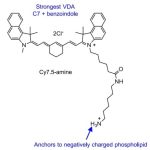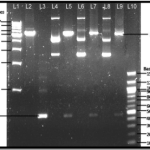Cell membrane is selectively permeable. This characteristic of the membrane allows certain substances to enter and leave a cell. It also prevents certain harmful materials from entering and some essential materials from leaving the cell. The transport across the membrane occurs in either active or passive manner.

Fig.1: Structure of Plasma membrane [source: Clark et al.,2020 ]
1. Passive transport: Metabolic energy is not used during this transport. It can be of three types; osmosis, simple diffusion and facilitated diffusion.
1.1 Osmosis: The movement of water through a semipermeable membrane, from a region of higher water concentration to the region of lower water concentration is called osmosis. The concentration gradient of water is inversely proportional to the concentration of solute. The movement continues until the concentration of solute is equalized in both sides of the membrane or until a pressure force prevents further flow of water.1

Fig 2: In the diagram, the solute cannot pass through the selectively permeable membrane, but the water can. (Source: By OpenStax – https://cnx.org/contents/FPtK1zmh@8.25:fEI3C8Ot@10/Preface)
Based on the concentration of solute present in the fluids on the either side of the membrane, the fluid or solution can be classified as follows:
- Isotonic: The solute concentration of intracellular and extracellular fluids is equal. Hence, there is no movement of water across membrane i.e. osmosis does not occur.
- Hypertonic: The solute concentration of extracellular fluid is higher than intracellular fluid. Hence, the water moves out (i.e. exosmosis) and the cell shrinks.
- Hypotonic: The solute concentration of intracellular fluid is higher than extracellular fluid. Hence, the water moves in (i.e. endosmosis) and the cell swells.
Both hypertonicity and hypotonicity in extreme amounts can be destructive to the cell.
1.2 Simple Diffusion: In simple diffusion, the transport across the membrane occurs unaided.1 The substances diffuse through the cytoplasmic membrane and equalizes concentration gradient (i.e.high concentration to low concentration). For instance, molecules of oxygen and Carbon dioxide and small molecules (e.g. ethanol) can enter the cell by crossing the plasma membrane without the help of any permease.

Fig 3: Diffusion through a permeable membrane [Source: Clark et al.,2020]
Several factors affect the rate of diffusion. Some of which are:
- Concentration gradient: As the difference in concentration of the fluids increases, the more rapid will be the diffusion.
- Mass of molecules: Heavier molecules have slower movement. Hence, they diffuse slowly.
- Density of solvent: Rate of diffusion decreases as the density of solvent increases. The denser medium slows the movement of molecule.2
- Solubility: Nonpolar or lipid soluble materials can diffuse across plasma membrane more easily than polar molecules.
1.3 Facilitated Diffusion: In facilitated diffusion, membrane proteins are used to diffuse across the plasma membrane. The process does not require metabolic energy and it only occurs in the direction of concentration gradient. It is faster than simple diffusion. Mostly, polar molecule ions are transported through this mode which is repelled by the cell membrane’s hydrophobic part. The transport proteins either function as channels or carriers for transport materials. 2

Fig 4: Facilitated transport moves substances down their concentration gradient. (Credit: modification of work by Mariana Ruiz Villareal)
- Channel Proteins: Hydrophilic channels are found in the core regions of these proteins which provides a hydrated opening through the membrane layers. It allows polar substances to avoid the plasma membrane’s nonpolar central layers, which would have slowed down or prevented their entry into the cell. These proteins are either open or gated. Cell involved in transmitting the electrical impulses such as nerve and muscle cells have gated channels for sodium, potassium, and calcium in their membranes. Such ion channels also occur in other types of cells such sperm and unfertilized ovum.
- Carrier proteins: These proteins are found embedded into the plasma membrane. Carrier proteins bind to a substance, triggering a change in its own shape, which allows the solute to be moved from the cell’s outside to its interior. The proteins are specific in nature. Transport of only a single species of ion or substance is possible through these proteins. Their activity is slower than that of channel proteins.
2. Active Transport: During active transport, metabolic energy ATP is used to move ions or molecules against their concentration gradient. The substances are not chemically modified as they are transported across the membrane. An active transport of solutes against their electrochemical gradient is essential to maintain the appropriate intracellular ionic composition of cells and to import solutes that are at lower concentration outside the cell than inside.3 Specific transport proteins, called pump or permeases are used during active transport.
Different permeases transport specific substrates or a few chemically similar substrates. Some permeases carry only one substrate at a time, they are called uniporters. Others can carry more than one substrate and are known as co-transporters. Among co-transporters, when two substrates are carried across the membrane in the same direction simultaneously, the process is called symport. Likewise, when two substrates are carried across the membrane, but in opposite direction, the process is called antiport.
Active transport can further be classified into two types; Primary and Secondary Active Transport.

Fig 5: Active transport process. Structure labelled A represents proteins (Credit: “Synaptitude”/Wikimedia Commons)
2.1 Primary Active Transport: It involves direct use of a source of chemical energy (eg. ATP) to move molecules across the membrane against their gradient.
Sodium-potassium pump uses this transport mechanism to maintain the electrochemical gradient in living cells. The sodium-potassium pump moves K+ into the cell while moving out Na+ at the same time. Na+-K+ ATPase is a transmembrane protein used during the process. It is believed that the hydrolysis of one ATP molecule somehow drives conformational changes in the Na+-k+ ATPase that allows the pump to transport three Na+ ions out and two K+ ions inside the cell.
2.2 Secondary Active Transport: It uses an electrochemical gradient, generated by active transport as an energy source to move molecules against their gradient.
It transports compounds like Na+ ions, some amino acids and glucose, into the cell. As Na+ ion concentration builds up outside of the plasma membrane because of the primary active transport process, electrochemical gradient is created. If the gates of channel proteins are open, the sodium ions will pull through the membrane. Some substances which can attach themselves to the transport protein can be transported across the plasma membrane through secondary transport mechanism.2
References:
- Dr. P.S. Verma, Dr. C.K. Agrawal. Cell Biology, Genetics, Molecular Biology, Evolution and Ecology. fourteenth. (Bharatnagar S, Pradhan S, eds.). S.CHAND & COMPANY PVT.LTD.; 2016.
- Clark MA, Choi J, Douglas M. Biology 2e. Second. The Rice University Press; 2020.
- Alberts B, Bray D, Hopkin K, Johnson A, Lewis J. Essential Cell Biology. Fourth. (Morales M, Jeffcock E, eds.). Garland Science, Taylor & Francis Group; 2014.
Related Content:
Factors affecting migration of Nucleic Acids in Agarose Gel Electrophoresis







